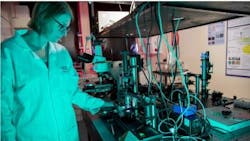Multimodal optical microscopy instrument to observe cancer cells in 4D
A three-year collaboration involving researchers at the University of Nottingham (Nottingham, England; the collaboration leader), Heriot-Watt University (Edinburgh, Scotland), and the University of Glasgow (Glasgow, Scotland) will develop an instrument that combines four optical microscopy technologies to image live cancer cells in 4D. The multimodal device will also plot, track, and analyze the cells' position, movement, and function as they grow into and interact with the proteins and sugars that make up their surrounding environment (the extracellular matrix).
This will enable scientists to understand how physical and biochemical cues from cells influence the matrix, and vice versa, and how these interactions affect the progression of disease.
"While a conventional microscope produces a sharp image from just a single object-plane, multiplaning records sharp images from several object planes simultaneously," says Paul Dalgarno of Heriot-Watt University, who pioneered a multiplane imaging technique that underpins the new instrument. "We will combine our revolutionary multiplane system with optical trapping before integrating this into the full light sheet-based trapping system of our co-collaborators. Together, this will enable us to fully study how cells migrate, grow, and interact in 3D and in real time."
The new approach will be important for developing therapies for diseases where cells respond abnormally to signals from their local matrix, such as cancer. The advancement in optical technology could also benefit research into degenerative diseases, regenerative medicine, and infection pathways as scientists build a better understanding that will ultimately inform treatments.
A second research strand will examine how cells absorb particles and the impact that drug therapies (such as functionalized polymer nanoparticles) have on the matrix. The findings could help to design new medicines and drug delivery systems targeted at the macromolecular level.
The research project is being funded by The Engineering and Physical Sciences Research Council (EPSRC) with co-funding from the Medical Research Council (MRC) and the Biotechnology and Biological Sciences Research Council (BBSRC).
For more information, please visit www.nottingham.ac.uk.
